Business Law: Analyzing the English Legal System and Solutions
VerifiedAdded on 2024/04/26
|24
|3497
|61
Report
AI Summary
This report provides an overview of the English legal system, discussing its structure, sources of law, and the roles of barristers, solicitors, and judges. It examines the legislative process and the relationship between statutory and common law, as well as the impact of EU law. The report evaluates the English legal system's advantages and disadvantages and further explores the impact of laws, regulations, and standards on business organizations, focusing on occupational health and safety, workers' compensation, harassment, and equal opportunity. It presents legal solutions to business problems, specifically addressing issues related to employment law and insurance policies, supported by relevant case laws. Alternative dispute resolution methods are suggested for resolving disputes personally to avoid litigation costs. The report concludes by recommending appropriate legal solutions based on alternative legal advice, emphasizing the importance of understanding legal implications for effective business practices.
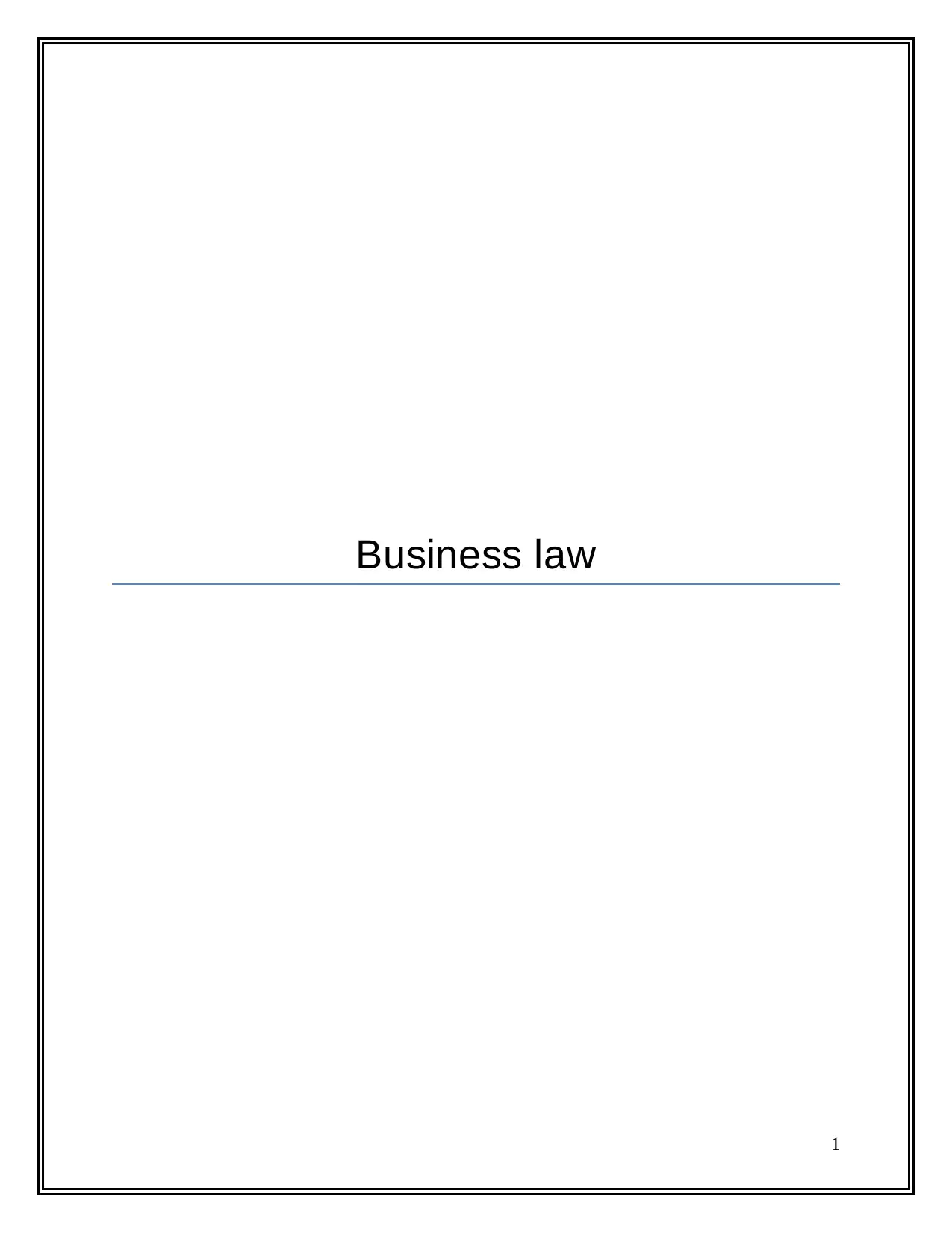
Business law
1
1
Paraphrase This Document
Need a fresh take? Get an instant paraphrase of this document with our AI Paraphraser
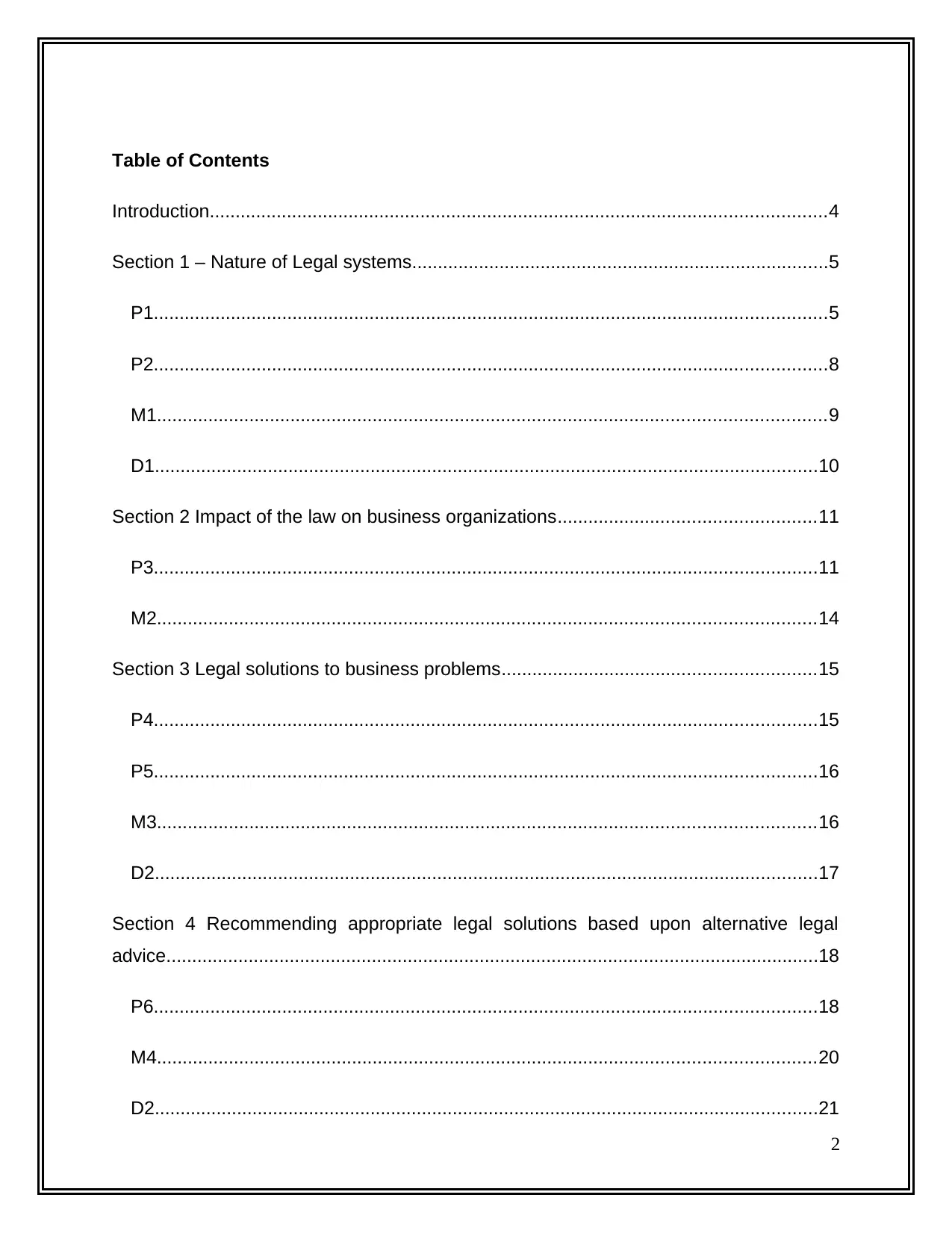
Table of Contents
Introduction........................................................................................................................4
Section 1 – Nature of Legal systems.................................................................................5
P1...................................................................................................................................5
P2...................................................................................................................................8
M1..................................................................................................................................9
D1.................................................................................................................................10
Section 2 Impact of the law on business organizations..................................................11
P3.................................................................................................................................11
M2................................................................................................................................14
Section 3 Legal solutions to business problems.............................................................15
P4.................................................................................................................................15
P5.................................................................................................................................16
M3................................................................................................................................16
D2.................................................................................................................................17
Section 4 Recommending appropriate legal solutions based upon alternative legal
advice...............................................................................................................................18
P6.................................................................................................................................18
M4................................................................................................................................20
D2.................................................................................................................................21
2
Introduction........................................................................................................................4
Section 1 – Nature of Legal systems.................................................................................5
P1...................................................................................................................................5
P2...................................................................................................................................8
M1..................................................................................................................................9
D1.................................................................................................................................10
Section 2 Impact of the law on business organizations..................................................11
P3.................................................................................................................................11
M2................................................................................................................................14
Section 3 Legal solutions to business problems.............................................................15
P4.................................................................................................................................15
P5.................................................................................................................................16
M3................................................................................................................................16
D2.................................................................................................................................17
Section 4 Recommending appropriate legal solutions based upon alternative legal
advice...............................................................................................................................18
P6.................................................................................................................................18
M4................................................................................................................................20
D2.................................................................................................................................21
2

Conclusion.......................................................................................................................22
References.......................................................................................................................23
3
References.......................................................................................................................23
3
⊘ This is a preview!⊘
Do you want full access?
Subscribe today to unlock all pages.

Trusted by 1+ million students worldwide
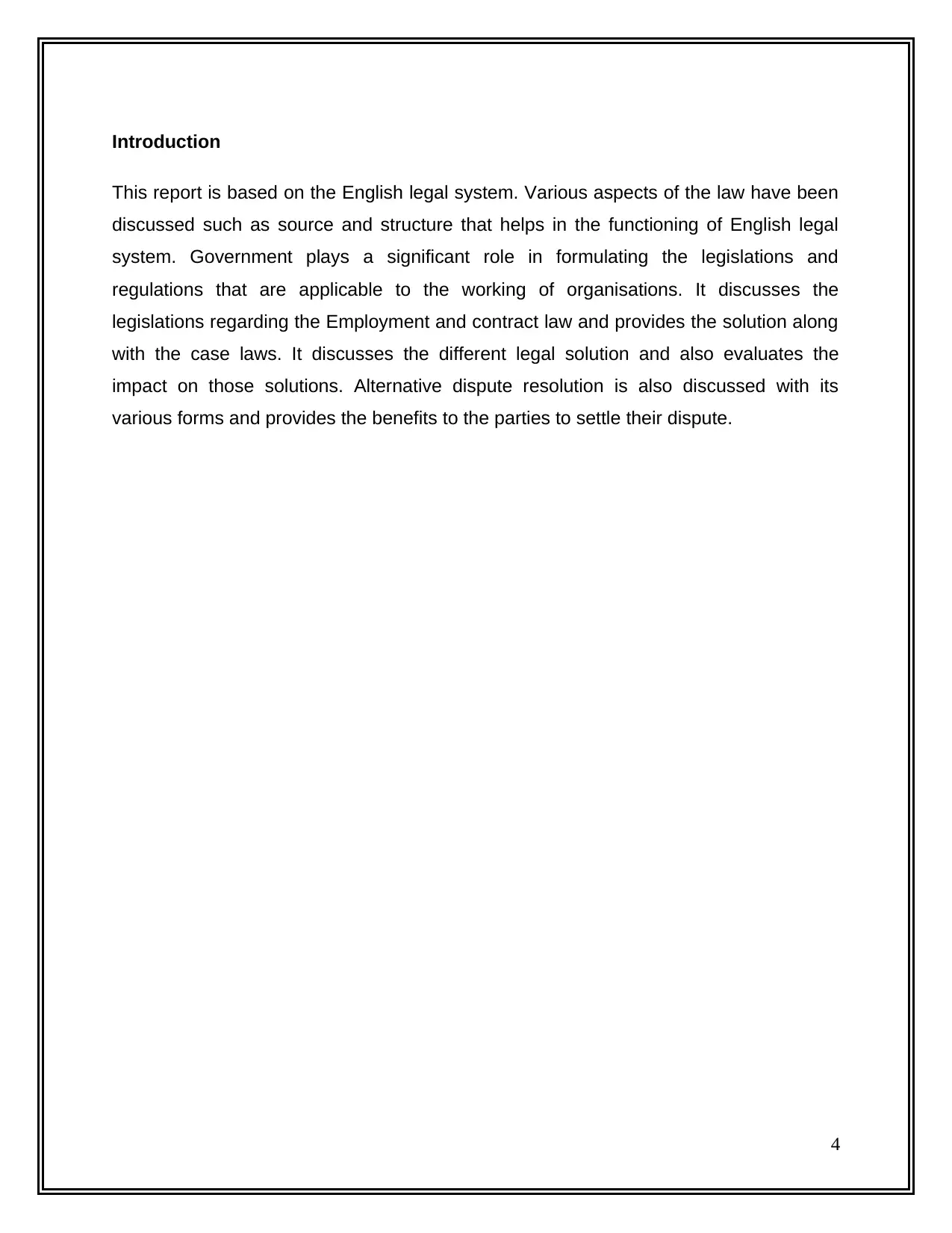
Introduction
This report is based on the English legal system. Various aspects of the law have been
discussed such as source and structure that helps in the functioning of English legal
system. Government plays a significant role in formulating the legislations and
regulations that are applicable to the working of organisations. It discusses the
legislations regarding the Employment and contract law and provides the solution along
with the case laws. It discusses the different legal solution and also evaluates the
impact on those solutions. Alternative dispute resolution is also discussed with its
various forms and provides the benefits to the parties to settle their dispute.
4
This report is based on the English legal system. Various aspects of the law have been
discussed such as source and structure that helps in the functioning of English legal
system. Government plays a significant role in formulating the legislations and
regulations that are applicable to the working of organisations. It discusses the
legislations regarding the Employment and contract law and provides the solution along
with the case laws. It discusses the different legal solution and also evaluates the
impact on those solutions. Alternative dispute resolution is also discussed with its
various forms and provides the benefits to the parties to settle their dispute.
4
Paraphrase This Document
Need a fresh take? Get an instant paraphrase of this document with our AI Paraphraser
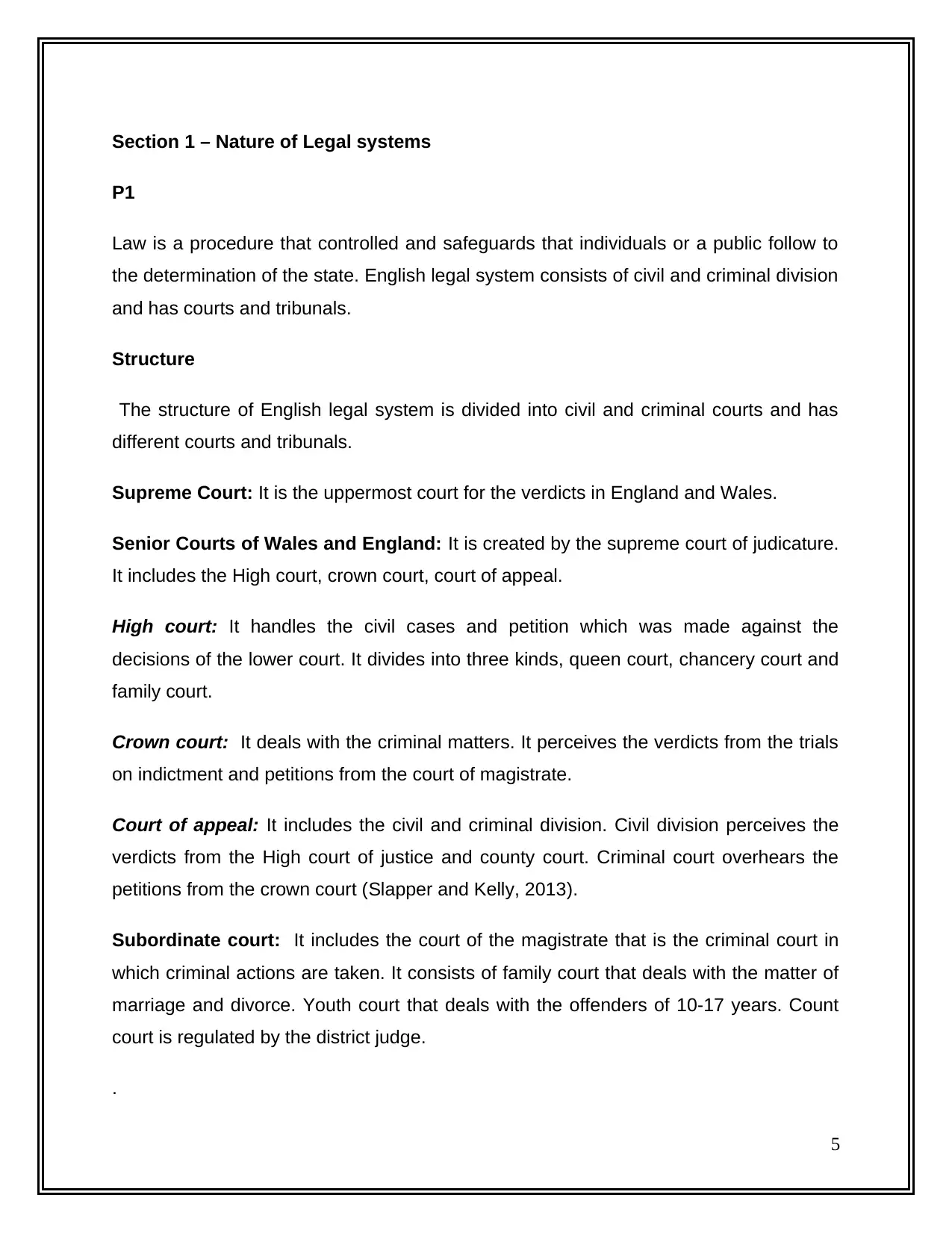
Section 1 – Nature of Legal systems
P1
Law is a procedure that controlled and safeguards that individuals or a public follow to
the determination of the state. English legal system consists of civil and criminal division
and has courts and tribunals.
Structure
The structure of English legal system is divided into civil and criminal courts and has
different courts and tribunals.
Supreme Court: It is the uppermost court for the verdicts in England and Wales.
Senior Courts of Wales and England: It is created by the supreme court of judicature.
It includes the High court, crown court, court of appeal.
High court: It handles the civil cases and petition which was made against the
decisions of the lower court. It divides into three kinds, queen court, chancery court and
family court.
Crown court: It deals with the criminal matters. It perceives the verdicts from the trials
on indictment and petitions from the court of magistrate.
Court of appeal: It includes the civil and criminal division. Civil division perceives the
verdicts from the High court of justice and county court. Criminal court overhears the
petitions from the crown court (Slapper and Kelly, 2013).
Subordinate court: It includes the court of the magistrate that is the criminal court in
which criminal actions are taken. It consists of family court that deals with the matter of
marriage and divorce. Youth court that deals with the offenders of 10-17 years. Count
court is regulated by the district judge.
.
5
P1
Law is a procedure that controlled and safeguards that individuals or a public follow to
the determination of the state. English legal system consists of civil and criminal division
and has courts and tribunals.
Structure
The structure of English legal system is divided into civil and criminal courts and has
different courts and tribunals.
Supreme Court: It is the uppermost court for the verdicts in England and Wales.
Senior Courts of Wales and England: It is created by the supreme court of judicature.
It includes the High court, crown court, court of appeal.
High court: It handles the civil cases and petition which was made against the
decisions of the lower court. It divides into three kinds, queen court, chancery court and
family court.
Crown court: It deals with the criminal matters. It perceives the verdicts from the trials
on indictment and petitions from the court of magistrate.
Court of appeal: It includes the civil and criminal division. Civil division perceives the
verdicts from the High court of justice and county court. Criminal court overhears the
petitions from the crown court (Slapper and Kelly, 2013).
Subordinate court: It includes the court of the magistrate that is the criminal court in
which criminal actions are taken. It consists of family court that deals with the matter of
marriage and divorce. Youth court that deals with the offenders of 10-17 years. Count
court is regulated by the district judge.
.
5
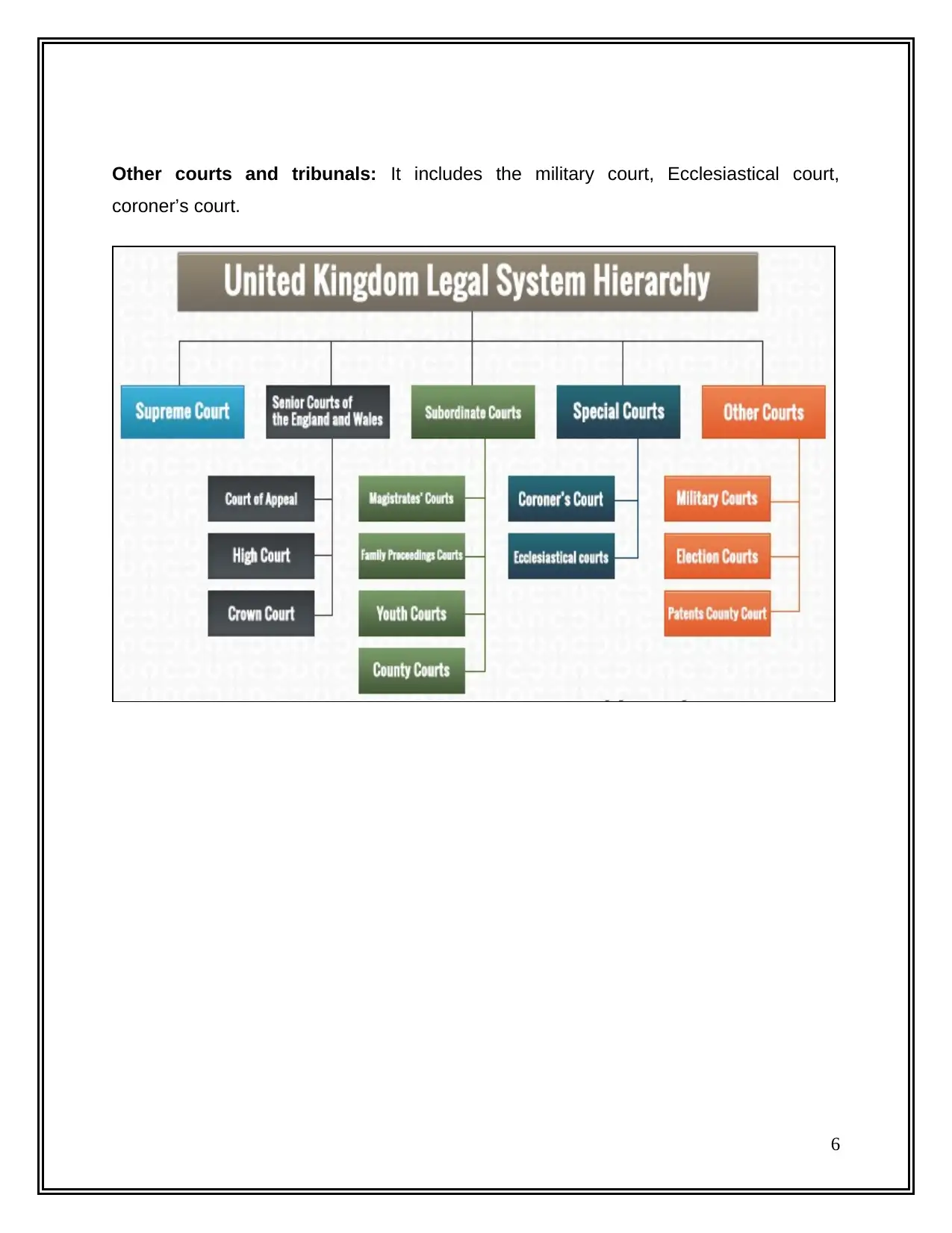
Other courts and tribunals: It includes the military court, Ecclesiastical court,
coroner’s court.
6
coroner’s court.
6
⊘ This is a preview!⊘
Do you want full access?
Subscribe today to unlock all pages.

Trusted by 1+ million students worldwide
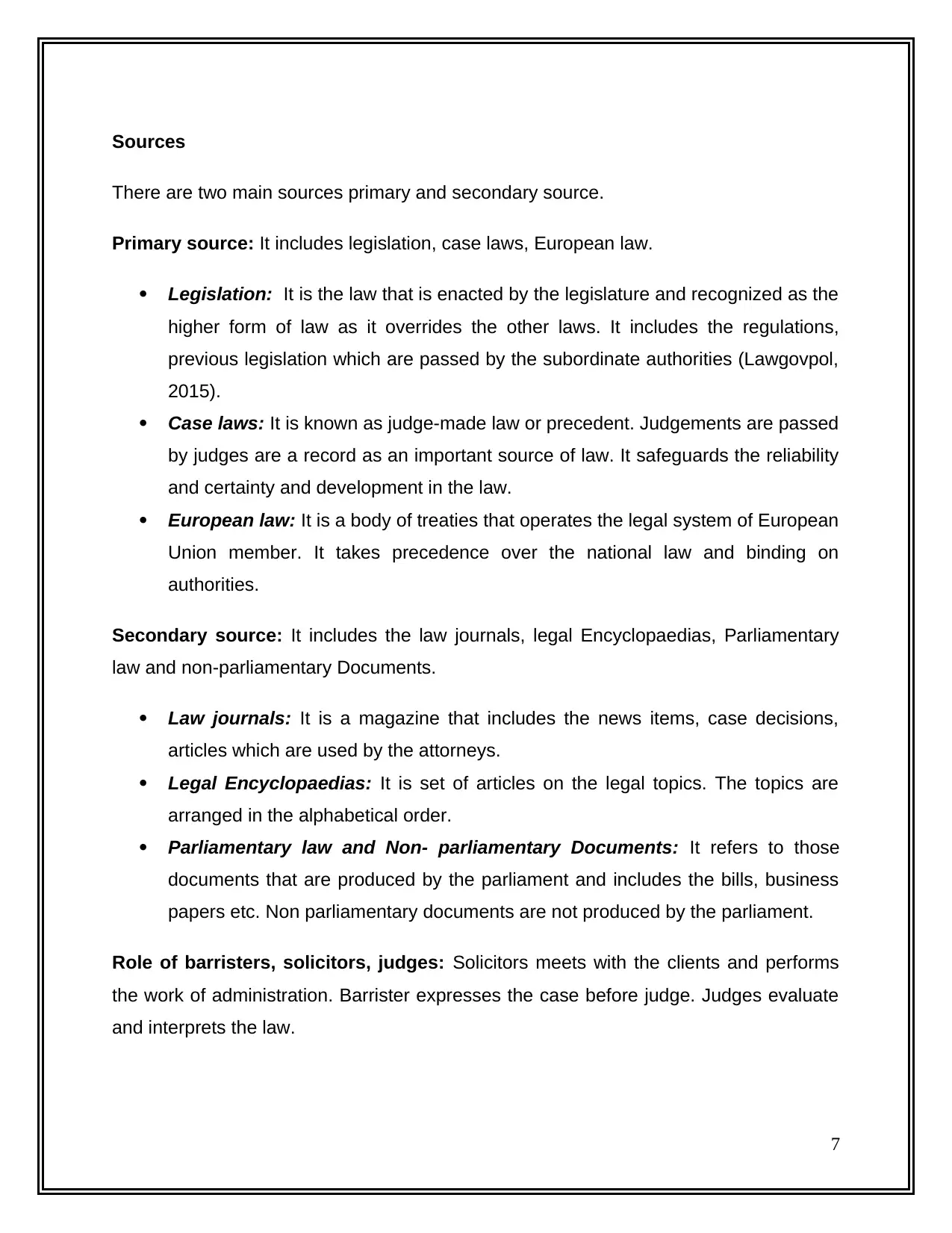
Sources
There are two main sources primary and secondary source.
Primary source: It includes legislation, case laws, European law.
Legislation: It is the law that is enacted by the legislature and recognized as the
higher form of law as it overrides the other laws. It includes the regulations,
previous legislation which are passed by the subordinate authorities (Lawgovpol,
2015).
Case laws: It is known as judge-made law or precedent. Judgements are passed
by judges are a record as an important source of law. It safeguards the reliability
and certainty and development in the law.
European law: It is a body of treaties that operates the legal system of European
Union member. It takes precedence over the national law and binding on
authorities.
Secondary source: It includes the law journals, legal Encyclopaedias, Parliamentary
law and non-parliamentary Documents.
Law journals: It is a magazine that includes the news items, case decisions,
articles which are used by the attorneys.
Legal Encyclopaedias: It is set of articles on the legal topics. The topics are
arranged in the alphabetical order.
Parliamentary law and Non- parliamentary Documents: It refers to those
documents that are produced by the parliament and includes the bills, business
papers etc. Non parliamentary documents are not produced by the parliament.
Role of barristers, solicitors, judges: Solicitors meets with the clients and performs
the work of administration. Barrister expresses the case before judge. Judges evaluate
and interprets the law.
7
There are two main sources primary and secondary source.
Primary source: It includes legislation, case laws, European law.
Legislation: It is the law that is enacted by the legislature and recognized as the
higher form of law as it overrides the other laws. It includes the regulations,
previous legislation which are passed by the subordinate authorities (Lawgovpol,
2015).
Case laws: It is known as judge-made law or precedent. Judgements are passed
by judges are a record as an important source of law. It safeguards the reliability
and certainty and development in the law.
European law: It is a body of treaties that operates the legal system of European
Union member. It takes precedence over the national law and binding on
authorities.
Secondary source: It includes the law journals, legal Encyclopaedias, Parliamentary
law and non-parliamentary Documents.
Law journals: It is a magazine that includes the news items, case decisions,
articles which are used by the attorneys.
Legal Encyclopaedias: It is set of articles on the legal topics. The topics are
arranged in the alphabetical order.
Parliamentary law and Non- parliamentary Documents: It refers to those
documents that are produced by the parliament and includes the bills, business
papers etc. Non parliamentary documents are not produced by the parliament.
Role of barristers, solicitors, judges: Solicitors meets with the clients and performs
the work of administration. Barrister expresses the case before judge. Judges evaluate
and interprets the law.
7
Paraphrase This Document
Need a fresh take? Get an instant paraphrase of this document with our AI Paraphraser
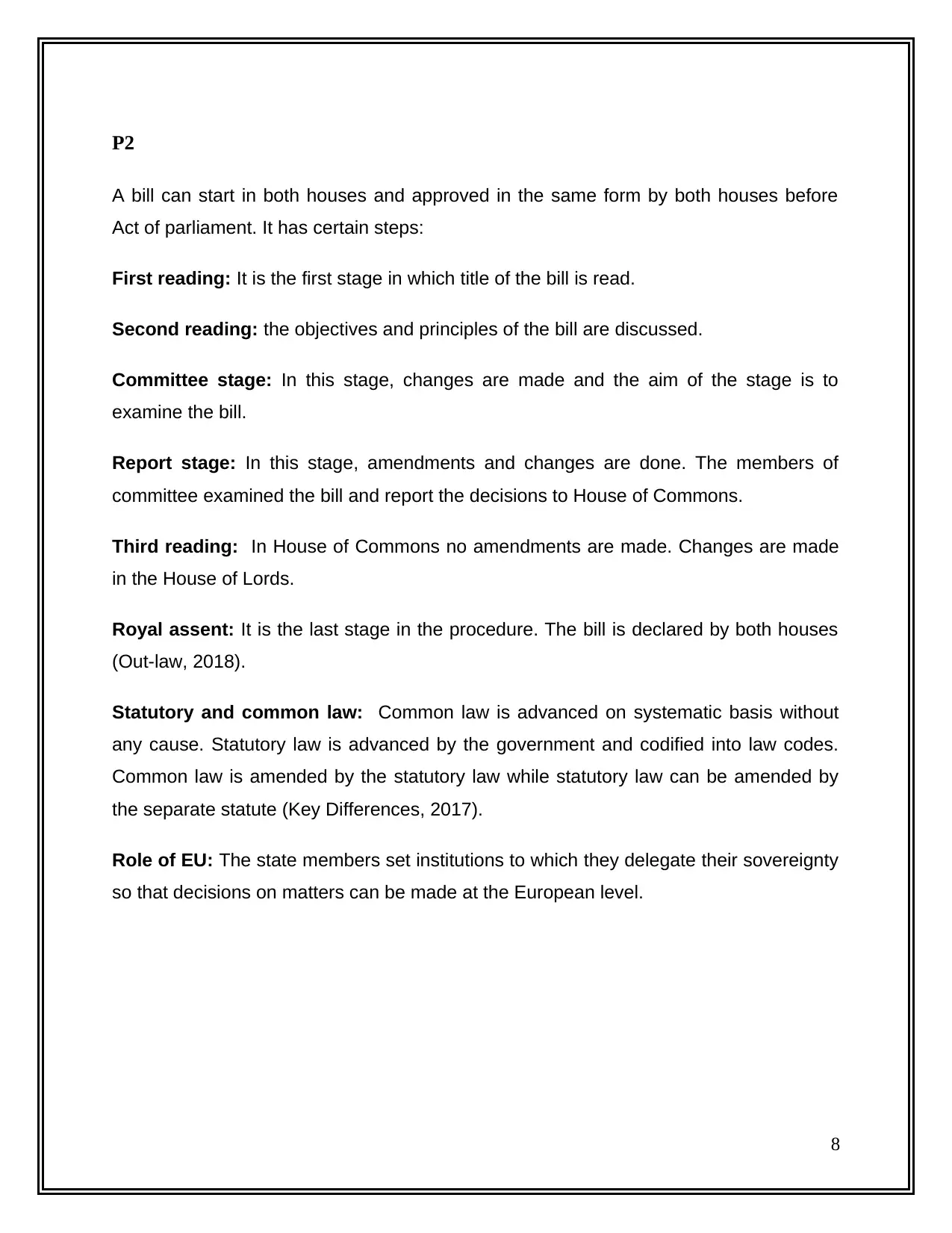
P2
A bill can start in both houses and approved in the same form by both houses before
Act of parliament. It has certain steps:
First reading: It is the first stage in which title of the bill is read.
Second reading: the objectives and principles of the bill are discussed.
Committee stage: In this stage, changes are made and the aim of the stage is to
examine the bill.
Report stage: In this stage, amendments and changes are done. The members of
committee examined the bill and report the decisions to House of Commons.
Third reading: In House of Commons no amendments are made. Changes are made
in the House of Lords.
Royal assent: It is the last stage in the procedure. The bill is declared by both houses
(Out-law, 2018).
Statutory and common law: Common law is advanced on systematic basis without
any cause. Statutory law is advanced by the government and codified into law codes.
Common law is amended by the statutory law while statutory law can be amended by
the separate statute (Key Differences, 2017).
Role of EU: The state members set institutions to which they delegate their sovereignty
so that decisions on matters can be made at the European level.
8
A bill can start in both houses and approved in the same form by both houses before
Act of parliament. It has certain steps:
First reading: It is the first stage in which title of the bill is read.
Second reading: the objectives and principles of the bill are discussed.
Committee stage: In this stage, changes are made and the aim of the stage is to
examine the bill.
Report stage: In this stage, amendments and changes are done. The members of
committee examined the bill and report the decisions to House of Commons.
Third reading: In House of Commons no amendments are made. Changes are made
in the House of Lords.
Royal assent: It is the last stage in the procedure. The bill is declared by both houses
(Out-law, 2018).
Statutory and common law: Common law is advanced on systematic basis without
any cause. Statutory law is advanced by the government and codified into law codes.
Common law is amended by the statutory law while statutory law can be amended by
the separate statute (Key Differences, 2017).
Role of EU: The state members set institutions to which they delegate their sovereignty
so that decisions on matters can be made at the European level.
8
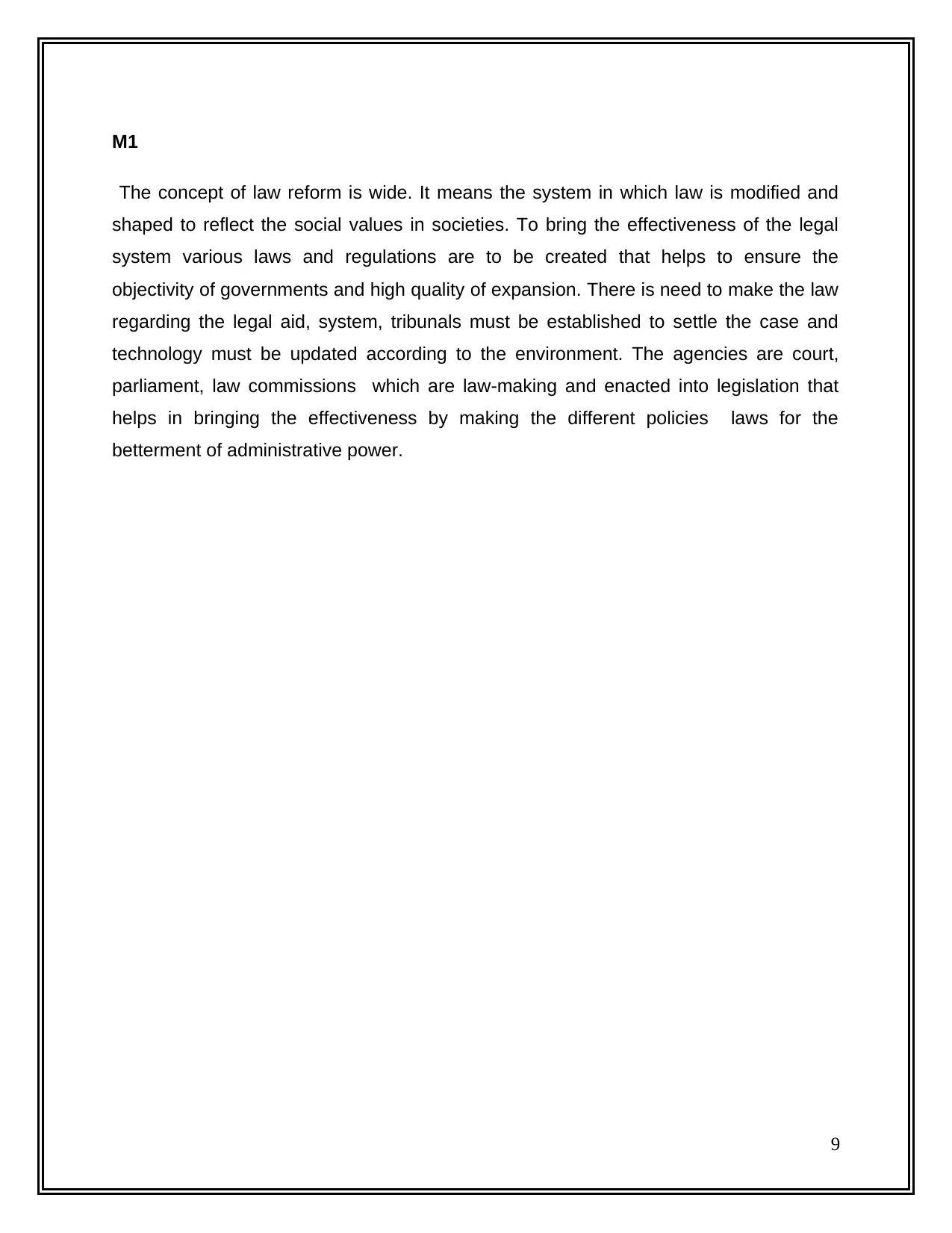
M1
The concept of law reform is wide. It means the system in which law is modified and
shaped to reflect the social values in societies. To bring the effectiveness of the legal
system various laws and regulations are to be created that helps to ensure the
objectivity of governments and high quality of expansion. There is need to make the law
regarding the legal aid, system, tribunals must be established to settle the case and
technology must be updated according to the environment. The agencies are court,
parliament, law commissions which are law-making and enacted into legislation that
helps in bringing the effectiveness by making the different policies laws for the
betterment of administrative power.
9
The concept of law reform is wide. It means the system in which law is modified and
shaped to reflect the social values in societies. To bring the effectiveness of the legal
system various laws and regulations are to be created that helps to ensure the
objectivity of governments and high quality of expansion. There is need to make the law
regarding the legal aid, system, tribunals must be established to settle the case and
technology must be updated according to the environment. The agencies are court,
parliament, law commissions which are law-making and enacted into legislation that
helps in bringing the effectiveness by making the different policies laws for the
betterment of administrative power.
9
⊘ This is a preview!⊘
Do you want full access?
Subscribe today to unlock all pages.

Trusted by 1+ million students worldwide
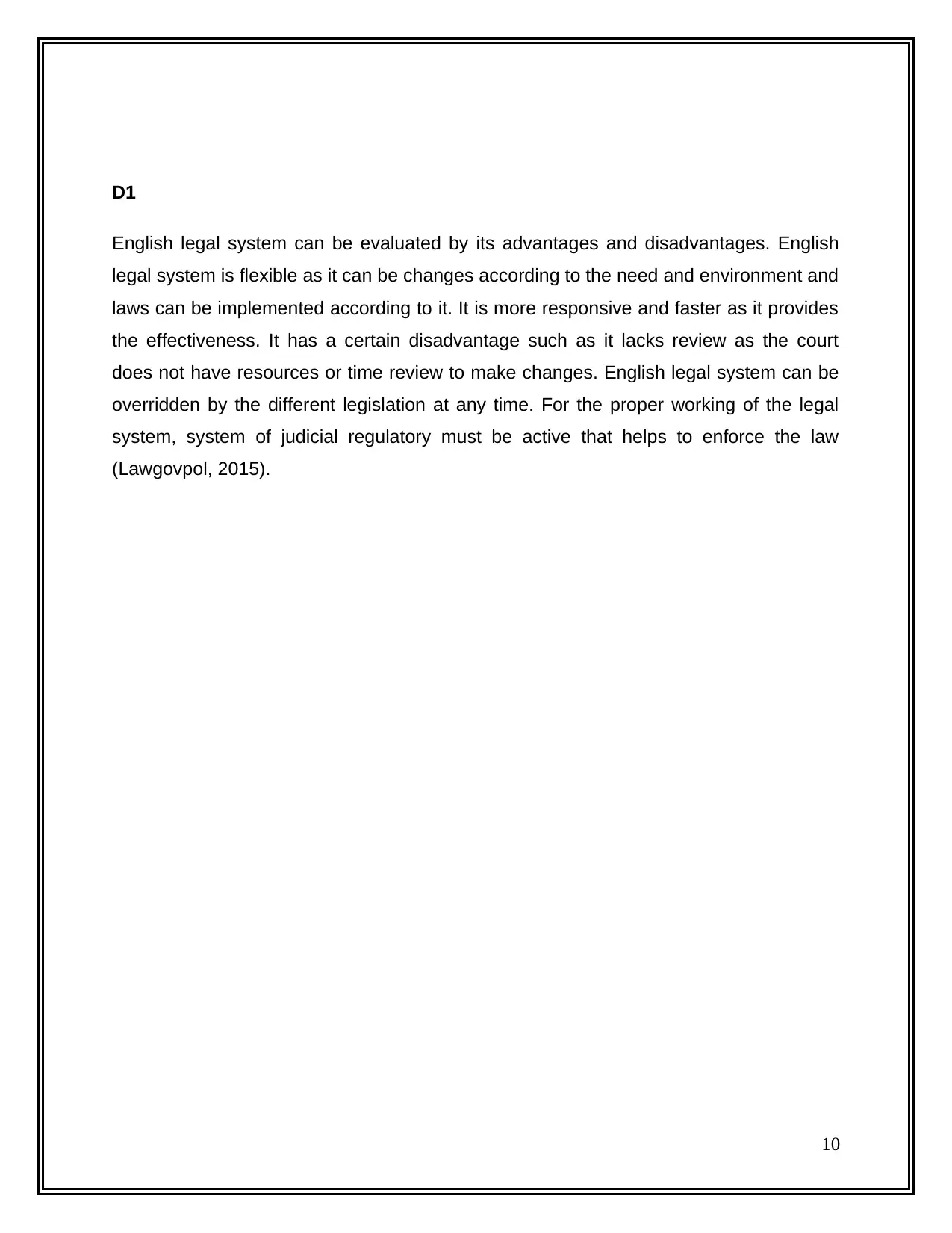
D1
English legal system can be evaluated by its advantages and disadvantages. English
legal system is flexible as it can be changes according to the need and environment and
laws can be implemented according to it. It is more responsive and faster as it provides
the effectiveness. It has a certain disadvantage such as it lacks review as the court
does not have resources or time review to make changes. English legal system can be
overridden by the different legislation at any time. For the proper working of the legal
system, system of judicial regulatory must be active that helps to enforce the law
(Lawgovpol, 2015).
10
English legal system can be evaluated by its advantages and disadvantages. English
legal system is flexible as it can be changes according to the need and environment and
laws can be implemented according to it. It is more responsive and faster as it provides
the effectiveness. It has a certain disadvantage such as it lacks review as the court
does not have resources or time review to make changes. English legal system can be
overridden by the different legislation at any time. For the proper working of the legal
system, system of judicial regulatory must be active that helps to enforce the law
(Lawgovpol, 2015).
10
Paraphrase This Document
Need a fresh take? Get an instant paraphrase of this document with our AI Paraphraser
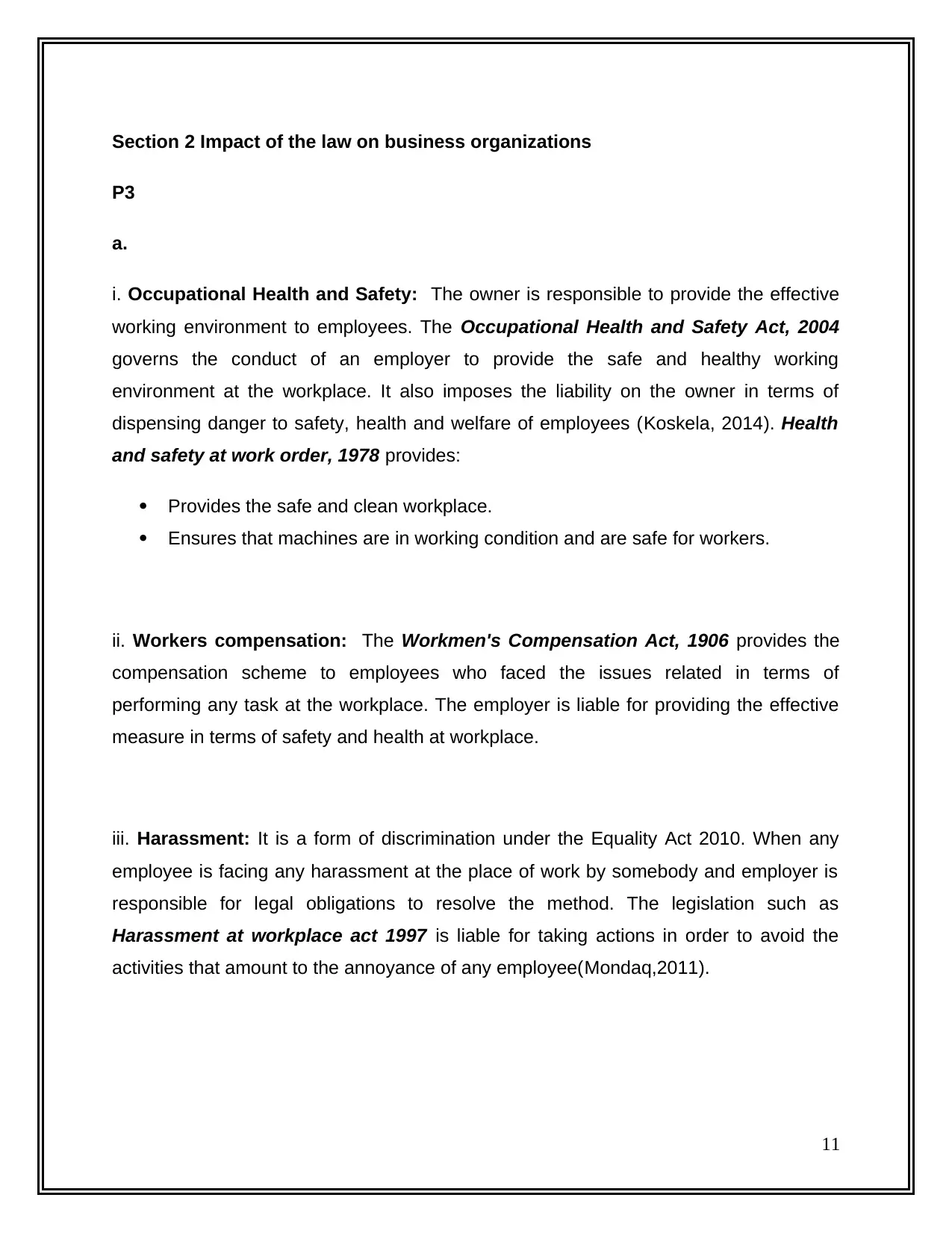
Section 2 Impact of the law on business organizations
P3
a.
i. Occupational Health and Safety: The owner is responsible to provide the effective
working environment to employees. The Occupational Health and Safety Act, 2004
governs the conduct of an employer to provide the safe and healthy working
environment at the workplace. It also imposes the liability on the owner in terms of
dispensing danger to safety, health and welfare of employees (Koskela, 2014). Health
and safety at work order, 1978 provides:
Provides the safe and clean workplace.
Ensures that machines are in working condition and are safe for workers.
ii. Workers compensation: The Workmen's Compensation Act, 1906 provides the
compensation scheme to employees who faced the issues related in terms of
performing any task at the workplace. The employer is liable for providing the effective
measure in terms of safety and health at workplace.
iii. Harassment: It is a form of discrimination under the Equality Act 2010. When any
employee is facing any harassment at the place of work by somebody and employer is
responsible for legal obligations to resolve the method. The legislation such as
Harassment at workplace act 1997 is liable for taking actions in order to avoid the
activities that amount to the annoyance of any employee(Mondaq,2011).
11
P3
a.
i. Occupational Health and Safety: The owner is responsible to provide the effective
working environment to employees. The Occupational Health and Safety Act, 2004
governs the conduct of an employer to provide the safe and healthy working
environment at the workplace. It also imposes the liability on the owner in terms of
dispensing danger to safety, health and welfare of employees (Koskela, 2014). Health
and safety at work order, 1978 provides:
Provides the safe and clean workplace.
Ensures that machines are in working condition and are safe for workers.
ii. Workers compensation: The Workmen's Compensation Act, 1906 provides the
compensation scheme to employees who faced the issues related in terms of
performing any task at the workplace. The employer is liable for providing the effective
measure in terms of safety and health at workplace.
iii. Harassment: It is a form of discrimination under the Equality Act 2010. When any
employee is facing any harassment at the place of work by somebody and employer is
responsible for legal obligations to resolve the method. The legislation such as
Harassment at workplace act 1997 is liable for taking actions in order to avoid the
activities that amount to the annoyance of any employee(Mondaq,2011).
11
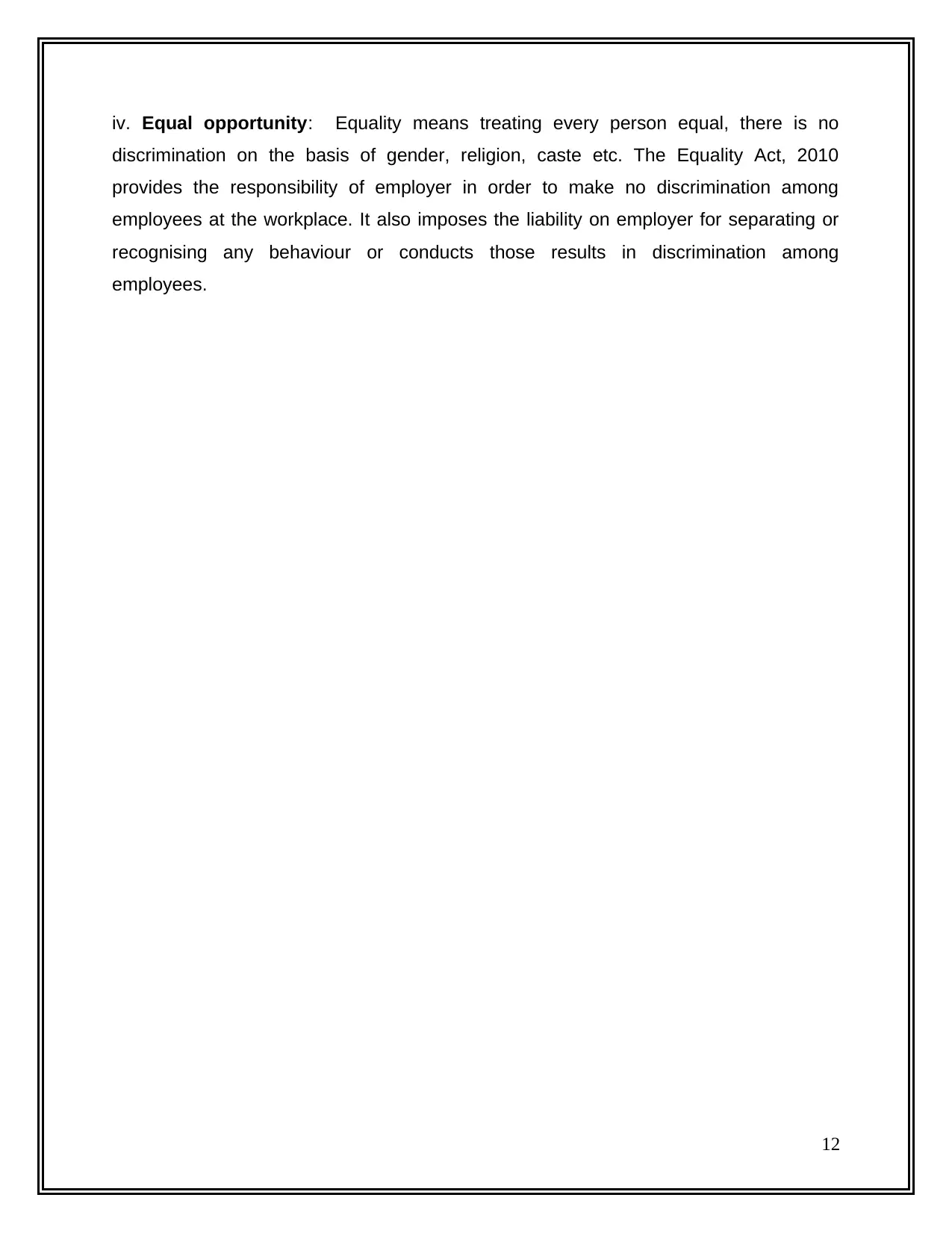
iv. Equal opportunity: Equality means treating every person equal, there is no
discrimination on the basis of gender, religion, caste etc. The Equality Act, 2010
provides the responsibility of employer in order to make no discrimination among
employees at the workplace. It also imposes the liability on employer for separating or
recognising any behaviour or conducts those results in discrimination among
employees.
12
discrimination on the basis of gender, religion, caste etc. The Equality Act, 2010
provides the responsibility of employer in order to make no discrimination among
employees at the workplace. It also imposes the liability on employer for separating or
recognising any behaviour or conducts those results in discrimination among
employees.
12
⊘ This is a preview!⊘
Do you want full access?
Subscribe today to unlock all pages.

Trusted by 1+ million students worldwide
1 out of 24
Related Documents
Your All-in-One AI-Powered Toolkit for Academic Success.
+13062052269
info@desklib.com
Available 24*7 on WhatsApp / Email
![[object Object]](/_next/static/media/star-bottom.7253800d.svg)
Unlock your academic potential
Copyright © 2020–2025 A2Z Services. All Rights Reserved. Developed and managed by ZUCOL.




